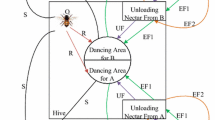Abstract
Evolutionary and meta-heuristic algorithms are widely used to solve water resources optimization problems. In this context, the honey bee mating optimization (HBMO) algorithm, inspired by the mating ritual of honey bees, is a reliable and efficient algorithm. The HBMO algorithm is modified in this work leading to the Enhanced HBMO (EHBMO) algorithm. The EHBMO is then applied to solve several unconstrained/constrained mathematical benchmark functions and a multi-reservoir problem. The performance of the EHBMO is compared with those of the elitist genetic algorithm (EGA) and the HBMO algorithm. The results show that the EHBMO achieves a better solution in a smaller number of functional evaluations and with less variance of results about global optima in comparison with the EGA and the HBMO algorithm.



Similar content being viewed by others
References
Aboutalebi M, Bozorg-Haddad O, Loáiciga H (2015) Optimal monthly reservoir operation rules for hydropower generation derived with SVR-NSGAII. J Water Resour Plan Manag 141(11)
Asgari H, Bozorg-Haddad O, Pazoki M, Loáiciga H (2015) Weed optimization algorithm for optimal reservoir operation. J Irrig Drain Eng 142(2)
Ashofteh PS, Bozorg-Haddad O, Akbari-Alashti H, Mariño M (2014) Determination of irrigation allocation policy under climate change by genetic programming. J Irrig Drain Eng 141(4)
Ashofteh PS, Bozorg-Haddad O, Loáiciga H (2015) Evaluation of climatic-change impacts on multiobjective reservoir operation with multiobjective genetic programming. J Water Resour Plan Manag 141(11)
Ashofteh PS, Bozorg-Haddad O, Loáiciga H (2016) Development of adaptive strategies for irrigation water demand management under climate change. J Irrig Drain Eng. doi:10.1061/(ASCE)IR.1943-4774.0001123
Back T (1994) Selective pressure in evolutionary algorithms: a characterization of selection mechanisms. IEEE world congress on computational intelligence, Orlando, FL, Jun 27–29, 57–62
Bozorg-Haddad O, Adams BJ, Mariño MA (2008b) Optimum rehabilitation strategy of water distribution systems using the HBMO algorithm. J Water Supply Res Technol 57(5):337–350
Bozorg-Haddad O, Afshar A, Mariño M (2010a) Multireservoir optimization in discrete and continuous domains. Proceeding of the ICE - Water Management 164(2):57–72
Bozorg-Haddad O, Afshar A, Mariño MA (2006) Honey-bees mating optimization (HBMO) algorithm: a new heuristic approach for water resources optimization. Water Resour Manag 20(5):661–680
Bozorg-Haddad O, Afshar A, Mariño MA (2008a) Design-operation of multi-hydropower reservoirs: HBMO approach. Water Resour Manag 22(12):1709–1722
Bozorg-Haddad O, Ghajarnia N, Solgi M, Loaiciga HA, Mariño MA (2016a) A DSS-Based Honeybee Mating Optimization (HBMO) Algorithm for Single- and Multi-objective Design of Water Distribution Networks. Metaheuristics and Optimization in Civil Engineering, Volume 7 of the series Modeling and Optimization in Science and Technologies, Springer International Publishing, 199–233 doi:10.1007/978-3-319-26245-1_10
Bozorg-Haddad O, Karimirad I, Seifollahi-Aghmiuni S, Loáiciga HA (2015a) Development and application of the bat algorithm for optimization the operation of reservoir systems. J Water Resour Plan Manag 141(8)
Bozorg-Haddad O, Mirmomeni M, Zarezadeh Mehrizi M, Mariño MA (2010b) Finding the shortest path with honey-bee mating optimization algorithm in project management problems with constrained/unconstrained resources. J Comput Optim Appl 47(1):97–128
Bozorg-Haddad O, Moravej M, Loáiciga HA (2015b) Application of the water cycle algorithm to the optimal operation of reservoir systems. J Irrig Drain Eng 141(5)
Bozorg-Haddad O,Hoseini-Ghafari S, Solgi M, Loáiciga HA (2016b) Intermittent urban water supply with protection of consumers’ welfare. J Pipeline Syst Eng Pract 7(3)
Chow VT, Cortez-Rivera G (1974) Application of DDDP in water resources planning. Department of Civil Engineering, University of Illinois at Urbana-Champaign, IL, USA
De Jong KA (1975) An analysis of the behavior of a class of genetic adaptive systems. Doctoral Dissertation, University of Michigan
East V, Hall MJ (1994) Water resources system optimization using genetic algorithms. Hydroinformatics ‘94, Proceeding of the 1st International Conference on Hydroinformatics, Delft, Netherlands, September 19–23
Fallah-Mehdipour F, Bozorg-Haddad O, Mariño MA (2012) Real-time operation of reservoir system by genetic programming. Water Resour Manag 26(14):4091–4103
Fallah-Mehdipour F, Bozorg-Haddad O, Mariño MA (2013) Developing reservoir operational decision rule by genetic programming. J Hydroinf 15(1):103–119
Garousi-Nejad I, Bozorg-Haddad O, Loáiciga HA (2016a) Modified firefly algorithm for solving multireservoiroperation in continuous and discrete domains. J Water Resour Plan Manag 142(9)
Garousi-Nejad I, Bozorg-Haddad O, Loáiciga H, Mariño MA (2016b) Application of the firefly algorithm to optimal operation of reservoirs with the purpose of irrigation supply and hydropower production. J Irrig Drain Eng. doi:10.1061/(ASCE)IR.1943-4774.0001064
Ghimire BNS, Reddy MJ (2013) Optimal reservoir operation for hydropower production using particle swarm optimization and sustainability analysis of hydropower. ISH J Hydraul Eng 19(3):196–210
Goldstein AA, Price JF (1971) On descent from local minima. Math Comput 25(115):569–574
Grefenstette JJ, Baker JE (1989) How genetic algorithms work: a critical look at implicit parallelism. Proceedings of the 3rd international conference on genetic algorithms, Morgan Kaufman Publishers, San Mateo, CA, USA, July, 20–27
Hennart JP (1982) Numerical analysis. Springer, Lecture notes in mathematics, 909
Holland JH (1975) Adaptation in natural and artificial systems. University of Michigan Press, Michigan
Jalali MR, Afshar A, Mariño MA (2006) Reservoir operation by ant colony optimization algorithms. Iranian Journal of Science and Technology, Shiraz
Maier HR, Kapelan Z, Kasprzyk J, Kollat J, Matott LS, Cunha MC, Dandy GC, Gibbs MS, Keedwell E, Marchi A, Ostfeld A, Savic D, Solomatine DP, Vrugt JA, Zecchin AC, Minsker BS, Barbour EJ, Kuczera G, Pasha F, Castelletti A, Giuliani M, Reed PM (2014) Evolutionary algorithms and other metaheuristics in water resources: current status, research challenges and future directions. Environ Model Softw 62:271–299
Michalewicz Z (1996) Genetic algorithms + data structures = evolution programs. Springer, New York
Michener CD, Grimaldi DA (1988) The oldest fossil bee: Apoid history, evolutionary stasis, and antiquity of social behavior. Proc Natl Acad Sci U S A 85(17):6424–6426
Moritz RFA, Southwick EE (1992) Bees as Superorganisms. Springer Verlag, Berlin
Murray DM, Yakowitz SJ (1979) Constrained differential dynamic programming and its application to multi-reservoir control. Water Resour Res 15(5):1017–1027
Nicklow J, Reed P, Savic D, Dessalegne T, Harrell L, Chan-Hilton A, Karamouz M, Minsker B, Ostfeld A, Singh A, Zechman E, ASCE Task Committee on Evolutionary Computation in Environmental and Water Resources Engineering (2010) State of the art for genetic algorithms and beyond in water resources planning and management. J Water Resour Plan Manag 136(4)
Soleimani S, Bozorg-Haddad O, Loáiciga H (2016) Reservoir operation rules with uncertainties in reservoir inflow and agricultural demand derived with stochastic dynamic programming. J Irrig Drain Eng. doi:10.1061/(ASCE)IR.1943-4774.0001065
Solgi M, Bozorg-Haddad O, Seifollahi-Aghmiuni S, Loáiciga HA (2015) Intermittent Operation of water distribution networks considering equanimity and justice principles. J Pipeline Syst Eng Pract 6(4)
Solgi M, Bozorg-Haddad O, Seifollahi-Aghmiuni S, Ghasemi-Abiazani P, Loáiciga HA (2016) Optimal operation of water distribution networks under water shortage considering water quality. J Pipeline Syst Eng Prac. doi:10.1061/(ASCE)PS.1949-1204.0000233
Tospornsampan J, Kita I, Ishii M, Kitamura Y (2005) Optimization of a multiple reservoir system using a simulated annealing: a case study in the Mae Klong system, Thailand. Paddy Water Environ 3(3):137–147
Wardlaw R, Sharif M (1999) Evolution of genetic algorithms for optimal reservoir system operation. J Water Resour Plan Manag 125(1):25–33
Whitley D (1989) The GENITOR algorithm and selection pressure: why rank-based allocation of reproduction trials is best. Proceedings of the third international conference on genetic algorithms, Morgan Kaufman Publishers, San Mateo, CA, USA, July, 116–121
Author information
Authors and Affiliations
Corresponding author
Rights and permissions
About this article
Cite this article
Solgi, M., Bozorg-Haddad, O. & Loáiciga, H.A. The Enhanced Honey-Bee Mating Optimization Algorithm for Water Resources Optimization. Water Resour Manage 31, 885–901 (2017). https://doi.org/10.1007/s11269-016-1553-x
Received:
Accepted:
Published:
Issue Date:
DOI: https://doi.org/10.1007/s11269-016-1553-x




